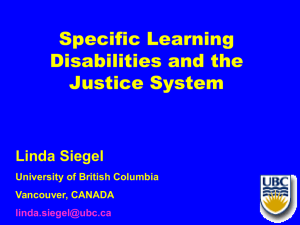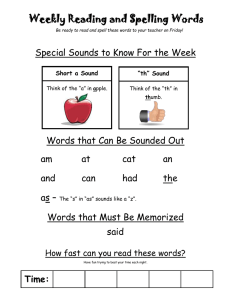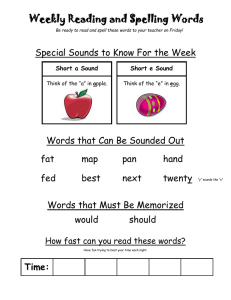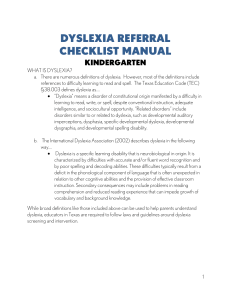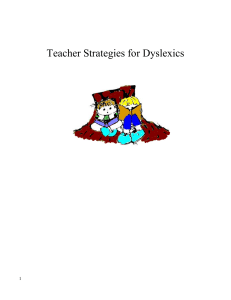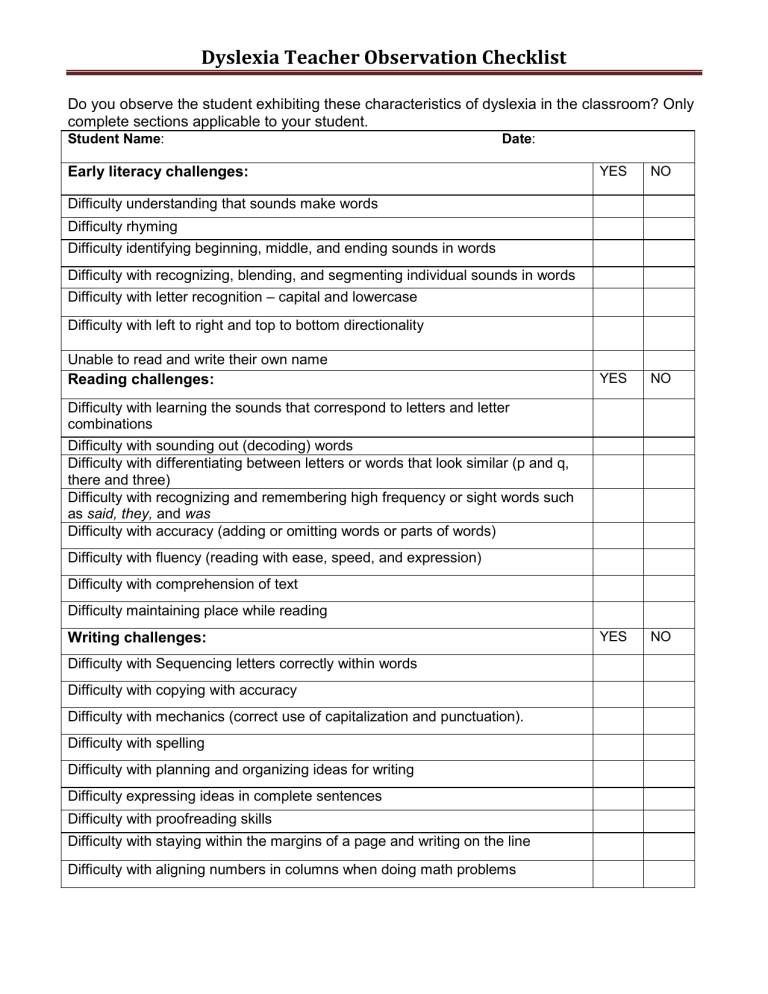
Dyslexia Teacher Observation Checklist Do you observe the student exhibiting these characteristics of dyslexia in the classroom? Only complete sections applicable to your student. Student Name: Date: Early literacy challenges: YES NO YES NO YES NO Difficulty understanding that sounds make words Difficulty rhyming Difficulty identifying beginning, middle, and ending sounds in words Difficulty with recognizing, blending, and segmenting individual sounds in words Difficulty with letter recognition – capital and lowercase Difficulty with left to right and top to bottom directionality Unable to read and write their own name Reading challenges: Difficulty with learning the sounds that correspond to letters and letter combinations Difficulty with sounding out (decoding) words Difficulty with differentiating between letters or words that look similar (p and q, there and three) Difficulty with recognizing and remembering high frequency or sight words such as said, they, and was Difficulty with accuracy (adding or omitting words or parts of words) Difficulty with fluency (reading with ease, speed, and expression) Difficulty with comprehension of text Difficulty maintaining place while reading Writing challenges: Difficulty with Sequencing letters correctly within words Difficulty with copying with accuracy Difficulty with mechanics (correct use of capitalization and punctuation). Difficulty with spelling Difficulty with planning and organizing ideas for writing Difficulty expressing ideas in complete sentences Difficulty with proofreading skills Difficulty with staying within the margins of a page and writing on the line Difficulty with aligning numbers in columns when doing math problems Dyslexia Teacher Observation Checklist Dyslexia Challenges to Look For in Specific Grades: Pre-K and Kindergarten YES NO YES NO YES NO Problems with pronouncing words correctly Delayed language and vocabulary development Difficulty in reciting the alphabet and days of the week sequentially Difficulty with quickly naming things (colors, shapes, familiar objects) when shown pictures of objects Frustration with coloring, pasting, and cutting with scissors Grades 1-4 Slowness in learning the connection between letters and sounds Letter reversals (b/d) and inversions (u/n) Lack of a systematic approach to sounding out words Difficulty in reading words (by sight and by decoding) Frustration with reading tasks Good comprehension of material that is read to the child as opposed to text that he/she tries to read Problem with recalling facts Difficulty in learning math facts, especially multiplication tables Problem with telling time and with understanding time concepts such as before and after Problems in understanding directions Grades 5-8 Weak decoding skills; slowness in figuring out multisyllabic words Poor sight word vocabulary Difficulty in learning spelling strategies such as root words, affixes, spelling patterns Poor oral reading; lack of fluency Difficulty with word problems in math Problems recalling facts Good oral self-expression, but not in writing Dyslexia Teacher Observation Checklist High School Poor spelling Poor written composition Avoidance of reading or writing assignments Incorrect reading of information Trouble with summarizing Poor memory skills Slow work speed Problems with organizing work and managing assignments Difficulty with performing in classes that have reading and writing demands Difficulty in learning a foreign language Alabama Dyslexia Resource Guide (PP. 10 & 11) YES NO



